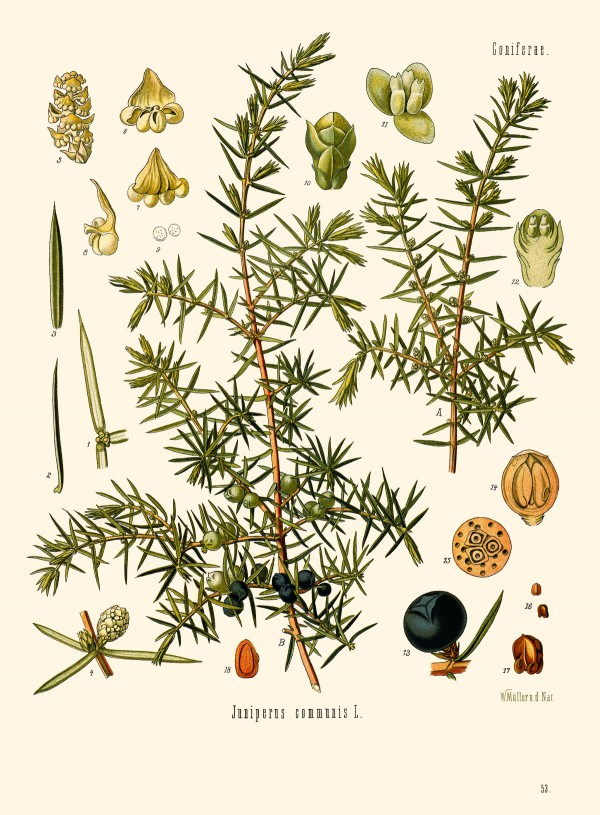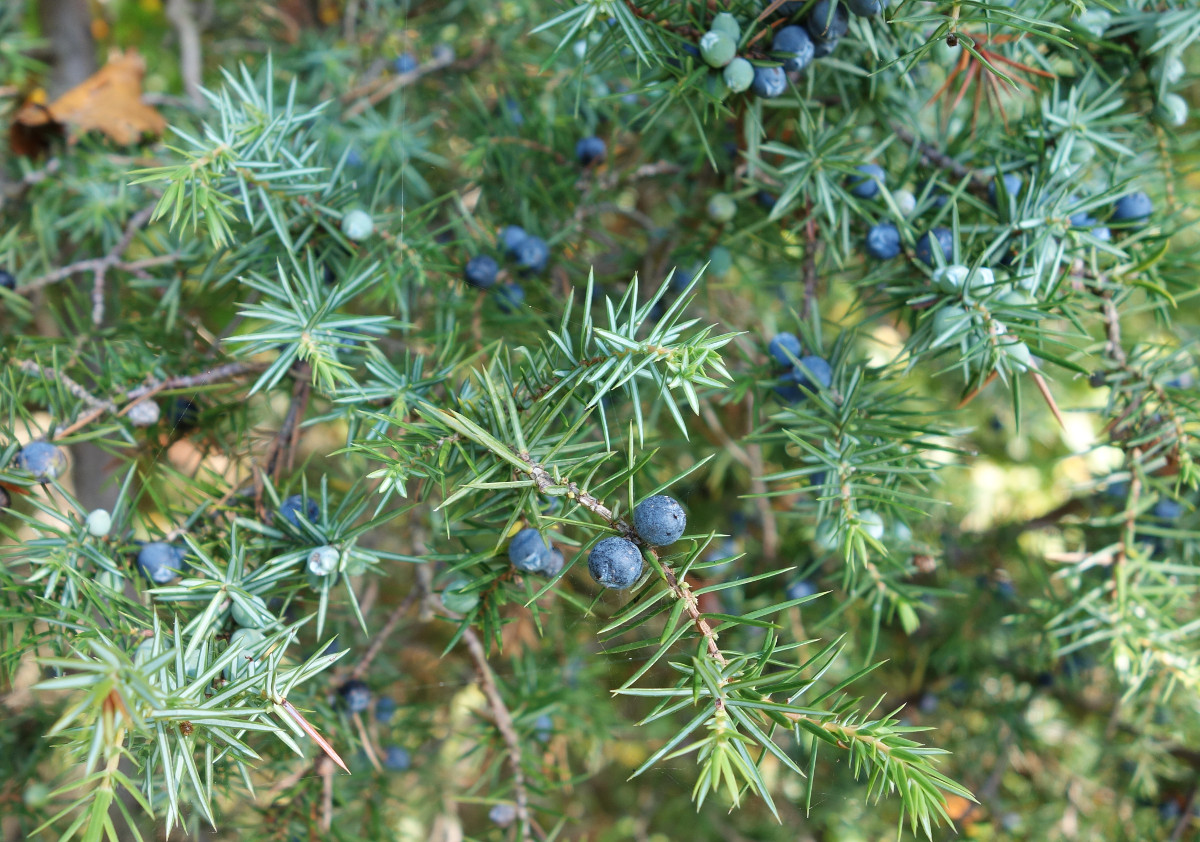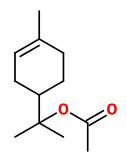Juniperus communis L. - Cypressaceae - common juniper, Gemeiner Wacholder
Evergreen coniferous shrub or tree, dioecious, very variable from low spreading to 10m high, native to the northern hemisphere; „Seed cones maturing in 2 years, of 2 distinct sizes, with straight peduncles, globose to ovoid, 6–13 mm, bluish black, glaucous, resinous to obscurely woody, with 2–3 seeds.“
http://www.efloras.org/florataxon.aspx?flora_id=1&taxon_id=200005424
„As to be expected from the wide range, J. communis is very variable, with several infraspecific taxa; delimitation between the taxa is still uncertain, with genetic data not matching morphological data well.“
http://en.wikipedia.org/wiki/Juniperus_communis
Dried seed cones, commonly known as „juniper berries“, are used as spice in European kitchen, especially for venison and sauerkraut (sour cabbage). There are juniper-flavored distilled beverages like gin and wacholder.
„Juniper berry oil is stated to possess a wide spectrum of pharmacological activities and its monographs are
included in some National Pharmacopoeias. The antibacterial and antifungal activity of the oil was reported
by some authors. In our study we estimated the antibacterial and antifungal activity of three different juniper
berry oils and their main components. All the micro-organisms used in this experiment were isolated from
patients of Regional Hospital of Gdansk and some of them showed resistance against commonly used antibiotics. Only one of the oils (labelled A) revealed good antimicrobial properties. None of the single oil components was a stronger antibacterial and antifungal inhibitor than the oil A itself. Our data suggest that the antimicrobial activity of juniper oil A is the result of either the specific composition of the oil A (highest concentration of α-pinene, p-cymene and β-pinene) or activity of a single non-identified compound. The presence of an adulterant in the oil was excluded.“
[Antibacterial and antifungal activity of juniper berry oil and its selected components. Filipowicz, N., Kamiński, M., Kurlenda, J., Asztemborska, M., & Ochocka, J. R., Phytotherapy Research, Vol.17(3), 2003, 227-231]
„The analysis of the essential oil from berries of J.communis L. subsp.alpina by CC, GC-RI, GC-MS and 13C-NMR allowed the identification of 65 compounds which represented 95.3% of the whole oil. Monoterpene hydrocarbons constituted the main group of compounds (82.0%), especially limonene (49.3%) and α-pinene (22.1%). Among the sesquiterpenes (7.9%), germacrene-D (2.0%), δ-cadinene (1.2%) and β-elemene (1.1%) were the major constituents. Oxygenated monoterpenes (5.3%) were largely represented by α-terpinyl acetate while the other compounds were present at very low content, less than 0.4%.“
[Analysis of Juniperus communis subsp. alpina needle, berry, wood and root oils by combination of GC, GC/MS and 13C‐NMR. Gonny, M., Cavaleiro, C., Salgueiro, L., & Casanova, J., Flavour and fragrance journal, Vol.21(1), 2004, 99-106] https://eg.sib.uc.pt/jspui/bitstream/10316/8377/1/obra.pdf
„The essential oil of juniper berry has diuretic properties, gastrointestinal irritant and antiseptic properties. The diuretic action of juniper is primarily due to its essential oil, which contains terpinen-4-ol. The content of essential oil in the berry ranges from 0.5 to 2.5% (V/m), and its main compounds are terpen hydrocarbons such as α- and β-pinene, myrcene, sabinene, thujone, limonene, etc. Oil also contains sesquiterpene hydrocarbons (caryophyllene, cadinene, elemene) and terpen alcohols (terpinen-4-ol)…
Juniper essential oil (Juniperi aetheroleum) was obtained from the juniper berry, and the GC/MS analysis showed
that the main compounds in the oil were α-pinene (29.17%) and β-pinene (17.84%), sabinene (13.55%), limonene (5.52%), and myrcene (0.33%). Juniper essential oil was evaluated for the antimicrobial activity against sixteen bacterial species, seven yeast-like fungi, three yeast and four dermatophyte strains. Juniper essential oil showed similar bactericidal activities against Gram-positive and Gram-negative bacterial species, with MIC values between 8 and 70% (V/V), as well as a strong fungicidal activity against yeasts,
yeast-like fungi and dermatophytes, with MIC values below 10% (V/V). The strongest fungicidal activity was recorded against Candida spp. (MIC from 0.78 to 2%, V/V) and dermatophytes (from 0.39 to 2%, V/V).“
[Antimicrobial activity of juniper berry essential oil (Juniperus communis L., Cupressaceae). Pepeljnjak, S., Kosalec, I., Kalodera, Z., Blazevic, N., Acta Pharmaceutica -ZAGREB-, 55(4), 2005, 417] http://hrcak.srce.hr/file/29715?origin=publication_detail
The main monoterpenoids (representing 70% of the sample’s volatile fraction) detected by SPME in the
headspace of juniper berries were terpinen-4-ol (22.5-30.6%), p-cymene (7.58-13.5%), β-myrcene (10.6-11.3%), ɣ-terpinene (3.0-10.1%), α-pinene (8.5-13.4%), limonene (4.4-5.9%) and α-terpinene (1.3-4.2%). Main sequiterpenoid was δ-cadinene (3.9-5.9%). Cis-rose oxide was found only by SPME (0.11-0.18%) but not not in SDE.
[HS-SPME coupled to GC/MS for quality control of Juniperus communis L. berries used for gin aromatization., Vichi, S., Riu-Aumatell, M., Mora-Pons, M., Guadayol, J. M., Buxaderas, S., López-Tamames, E., Food Chemistry, 105(4), 1748-1754, 2007]
Main components of an industrial essential oil from the branches were α-pinene (18.7%) and thujopsene (25.3%). Minor constiuents were monoterpenes like α-thujene, α-pinene, sabinene, terpinen-4-ol, α-terpineol, α-terpinyl acetate, and sesquiterpenes like α-cedrene, β-cedrene, cuparene, cedrol, β-caryophyllene, α-humulene, germacrene D and δ-cadinene e.g.
„The presence of thujopsene distinguishes juniper branches oil from juniper berry oils and juniper needle oils.“
[Bats, J. P., et al. „Chemical composition of an industrial essential oil from juniper branches (Juniperus communis L.).“ Proceedings of the 11th International Congress of essential oils, fragrances and flavours. New Delhi, India, 12-16 November, 1989 Vol. 4 Chemistry-analysis and structure.. Aspect Publishing, 1990]
The root oil of Juniperus communis subsp.alpina showed a very special composition of sesquiterpenes with cedrol (37%), longifolene (11%), longiborneol (8%), α-cedrene (6%), nootkatone (3%), β-cedrene (1.4%), thujopsene (1.1%) and valencene (1.7%).
[Analysis of Juniperus communis subsp. alpina needle, berry, wood and root oils by combination of GC, GC/MS and 13C‐NMR. Gonny, M., Cavaleiro, C., Salgueiro, L., & Casanova, J., Flavour and fragrance journal, Vol.21(1), 2004, 99-106]
https://eg.sib.uc.pt/jspui/bitstream/10316/8377/1/obra.pdf
„Oil can be extracted from needles, cones and wood (Berta 1993; Stanićet al. 1998); relative yields (w/w) were reported in J. communis ssp. nana as 0.78%, 0.70% and 0.12% (Marongiu et al. 2006). Qualitative differences have been found between oils from different plant parts. Gonny et al. (2006) working with ssp. nana found the oils of leaves, cones and wood to be rich in monoterpenes but root oil was dominated by sesquiterpenes with low amounts of monoterpenes. Shahmir et al. (2003) reported that leaves from north Iran contained sabinene (40.7%), α-pinene (12.5%), terpinen-4-ol (12.3%) while cones contained sabinene (36.8%), α-pinene (20%), limonene (10.6), germacrene-D (8.2%) and myrcene (4.8%). Marongiu et al. (2006) examining ssp. nana from Italy noted that leaf oils were made up of limonene (36.2%), β-selinene (15.2%) and α-terpinyl acetate (5.3%) whereas oil from cones was composed chiefly of limonene (40.1%), germacrene D (17.2%) and α-pinene (4.7%), and the small amount of oil derived from wood consisted of limonene (8.9%), α-terpinyl acetate (9.7%) and germacrene D (8.6%). Butkiene et al. (2006) working in Lithuania found that oil from unripe cones contained a larger amount of α-pinene than oil from leaves or ripe cones from the same plant. The amount of myrcene was larger in cone than leaf oil and increased during ripening; the opposite trend was found for beta-phellandrene.“
[Biological Flora of the British Isles: Juniperus communis L., Thomas, P. A., El‐BarghathiI, M., Polwart, A., Journal of Ecology, Vol.95(6), 2007, 1404-1440] http://onlinelibrary.wiley.com/doi/10.1111/j.1365-2745.2007.01308.x/full
(3E,5Z)-undeca-1,3,5-triene (0.02%) is a key odorant of the needle scent of Juniperus communis.
[Scent of a vanishing flora, Roman Kaiser, 2011, 170]
Aroma-active compounds with the highest flavor dilution (FD) factors, identified in distillates obtained from two different Bavarian gins, were: (Z)-rose oxide, linalool, anethole, eugenol, limonene, δ-carene, octanal, coumarin, α-pinene, γ-terpinene, myrcene, (E,E)-2,6-nonadienal, nonanal, and hexanal.
[Buck, Nina, et al. „Key Aroma Compounds in Two Bavarian Gins.“ Applied Sciences 10.20 (2020): 7269] https://www.mdpi.com/2076-3417/10/20/7269/pdf

Köhler, F.E., Medizinal Pflanzen, vol.1 t.53 (1887) [W. Müller]
http://plantgenera.org/species.php?id_species=570443

Juniperus communis, CC BY-SA 3.0, Author: Andreas Kraska




